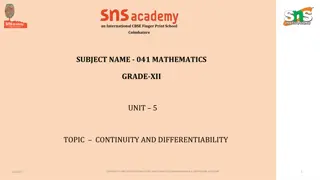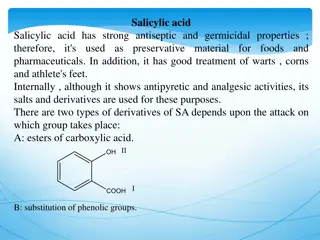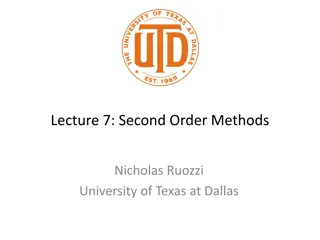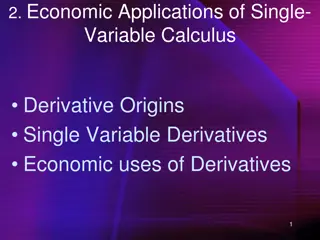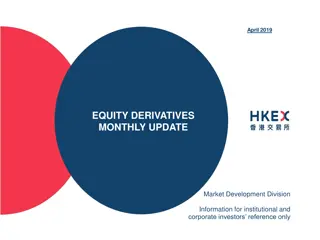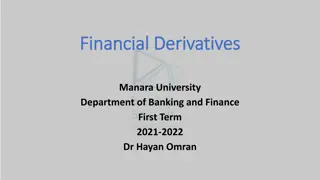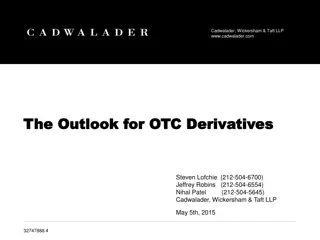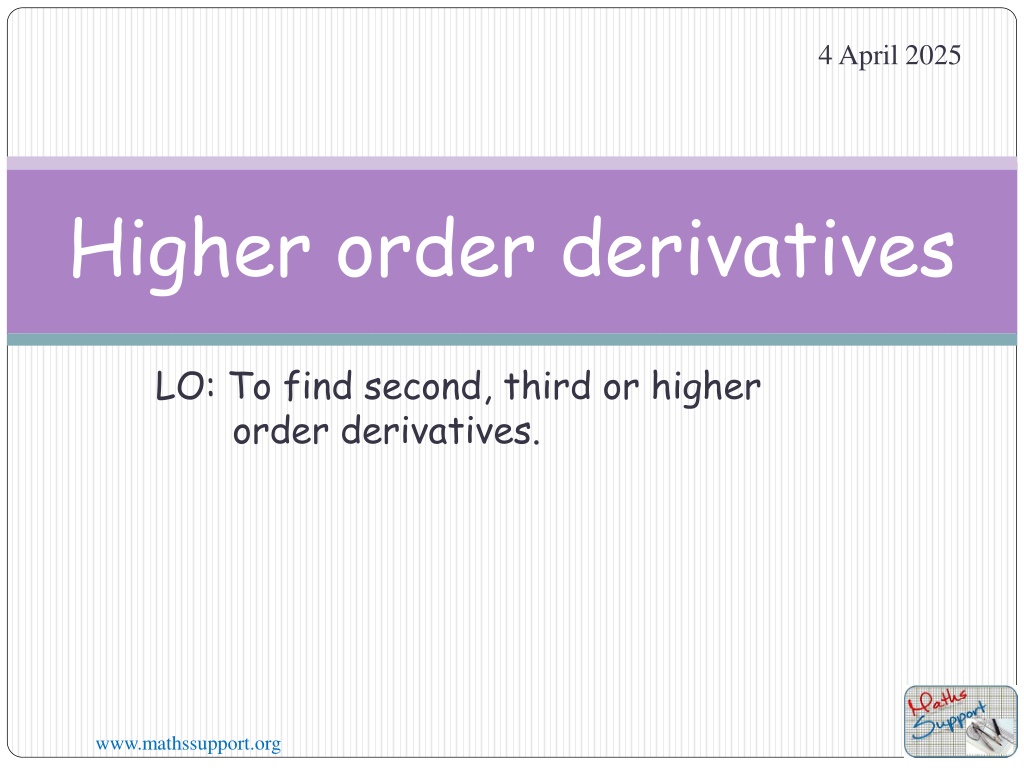
Understanding Higher Order Derivatives in Mathematics
Explore the concept of higher order derivatives in mathematics by delving into finding second, third, or higher order derivatives of functions. Learn how to interpret second order derivatives in the context of velocity and acceleration functions. Discover the notation and efficiency of expressing higher derivatives beyond the third order. Practice differentiating functions to compute higher order derivatives effectively.
Download Presentation

Please find below an Image/Link to download the presentation.
The content on the website is provided AS IS for your information and personal use only. It may not be sold, licensed, or shared on other websites without obtaining consent from the author. If you encounter any issues during the download, it is possible that the publisher has removed the file from their server.
You are allowed to download the files provided on this website for personal or commercial use, subject to the condition that they are used lawfully. All files are the property of their respective owners.
The content on the website is provided AS IS for your information and personal use only. It may not be sold, licensed, or shared on other websites without obtaining consent from the author.
E N D
Presentation Transcript
4 April 2025 Higher order derivatives LO: To find second, third or higher order derivatives. www.mathssupport.org
Higher order derivatives Let s start this lesson with the following function. f(x) = 2x5 3x3 + 5x 4 By this point we should be able to differentiate this function = 10x4 9x2 + 5 f (x) Now, this is a function and so it can be differentiated. and this is the derivative. We use this notation, f (x) = 40x3 18x , and f (x) is now called This is called the second derivative the first derivative. Again, this is a function, so we can differentiate it again. f (x) = 120x2 18 This is called the third derivative. We can differentiate again. = 240x f (4)(x) This is called the fourth derivative. Differentiate it again. = 240 f (5)(x) www.mathssupport.org
Second order derivatives If f is a differentiable function, then f (x) is the first derivative of f(x). or f (x) dy dx If f (x) is a differentiable function, then f (x) is the derivative of f (x). Differentiating the function a second time give us the second order derivative. This can be written as 2 d y dx f (x) or 2 The second order derivative gives us the rate of change of the gradient of a function. We can think of it as the gradient of the gradient. www.mathssupport.org
Second order derivatives Now we will talk about an interpretation of the second derivative If s(t) is the position function of an object Differentiating the position function give us the velocity function v(t) s (t) = If we differentiate the velocity it will be the acceleration function. a(t) = v (t) = s (t) The acceleration of the object is the first derivative of the velocity, but we say is the second derivative of the position function.. www.mathssupport.org
Higher order derivatives Similarly, If f (x) is a differentiable function, then f (x) is the derivative of f (x). or f (x) ?3? ??3 Since a derivative of a function is a differentiable function we can differentiate and we will have a higher order derivative. Since multiple dash or prime notation begins to lose its efficiency after about the third derivative, for higher derivatives we write f(n)(x) . We can use either notation. ??? ??? f (n)(x) n =4, 5, 6, or www.mathssupport.org
Higher order derivatives 2 d y dx ?3? ??3 dy dx Given that y = 3x5+ find: a) b) c) 2 dy dx 2 d y dx a) b) = 60x3+ 24x-4 2 y = 3x5+ = 60x3+ y = 3x5+ 4x-2 ?3? ??3 c) = 180x2- 96x-5 dy dx = 15x4- 8x-3 = 180x3 -96 ?5 dy dx = 15x4- www.mathssupport.org
Higher order derivatives b) f (x) a) Given that f (x) = , find: f (x) a) b) f (x) f (x) = f (x) = f (x)= f (x) = 3 1 f (x)= 2 ? 4 ?3 www.mathssupport.org
Higher order derivatives Find the first four derivatives for this function f (x) = sin (3x) + e 2x + ln (7x) + 1 2e 2x f (x) = 3 cos (3x) y = sin (u) ?? ??= cos (u) u = 3x ? ?? ??= 3 z = ev ?? ??= ev v = 2x ?? ??= 2 r = ln (w) ?? ??= w = 7x ?? ??= 1 ? 7 www.mathssupport.org
Higher order derivatives Find the first four derivatives for this function f (x) = sin (3x) + e 2x + ln (7x) 2e 2x + 1 f (x) = 3 cos (3x) y = 3cos (u) ?? ??=-3sin (u) u = 3x ? ?? ??= 3 9sin (3x) + 4e 2x x 2 f (x) = z = 2ev ?? ??= 2ev v = 2x ?? ??= 2 www.mathssupport.org
Higher order derivatives Find the first four derivatives for this function f (x) = sin (3x) + e 2x + ln (7x) 2e 2x + 1 f (x) = 3 cos (3x) y = -9sin (u) ?? ??=-9cos (u) u = 3x ? ?? ??= 3 9sin (3x) + 4e 2x x 2 f (x) = z = 4ev ?? ??= 4ev v = 2x = 27cos (3x) 8 e 2x+ 2x 3 ?? ??= f (x) 2 www.mathssupport.org
Higher order derivatives Find the first four derivatives for this function f (x) = sin (3x) + e 2x + ln (7x) 2e 2x + 1 f (x) = 3 cos (3x) y = -27cos (u) ?? ??=27sin (u) u = 3x ? ?? ??= 3 e 2x x 2 9sin (3x) + 4 f (x) = z = 8ev ?? ??= 8ev v = 2x = 27cos (3x) 8 e 2x+ 2x 3 ?? ??= f (x) 2 81sin (3x) + 16e 2x 6x 4 f (4)(x) = www.mathssupport.org
Thank you for using resources from A close up of a cage Description automatically generated For more resources visit our website https://www.mathssupport.org If you have a special request, drop us an email info@mathssupport.org www.mathssupport.org

